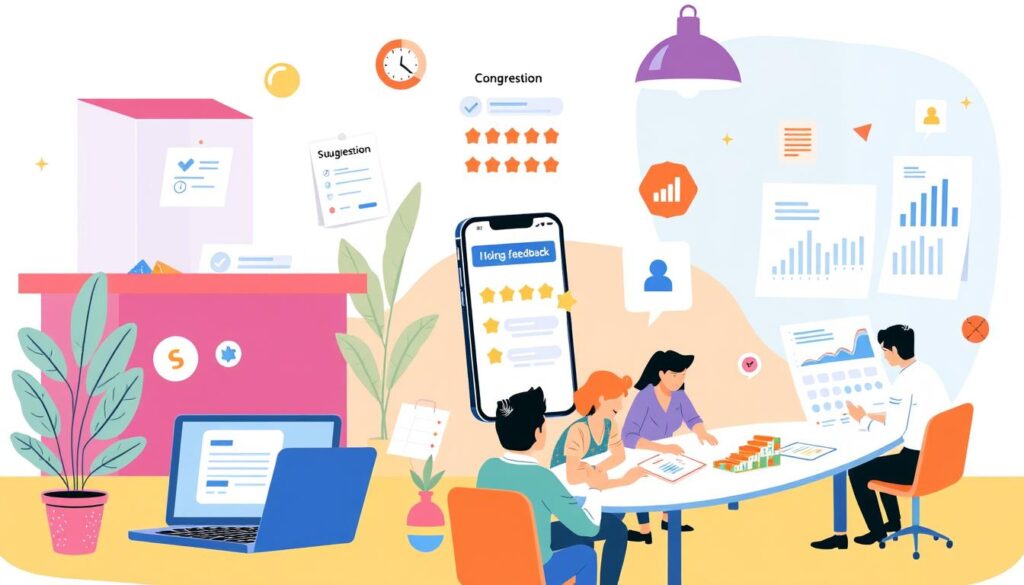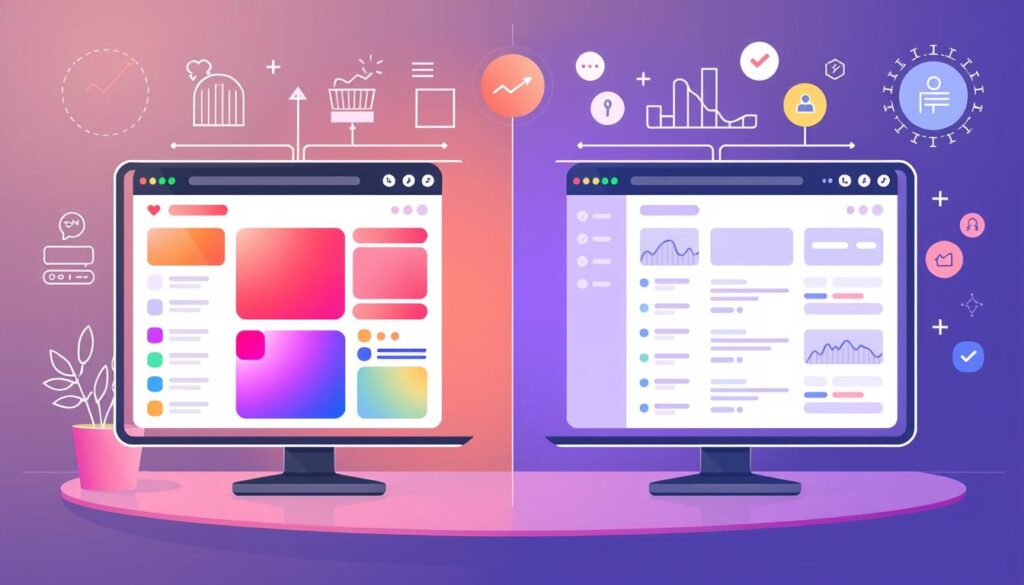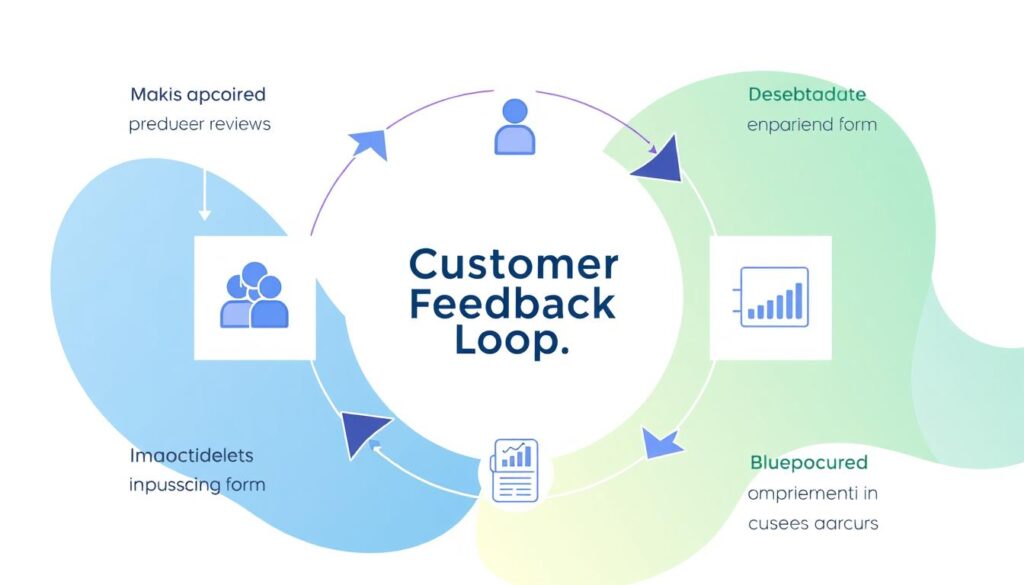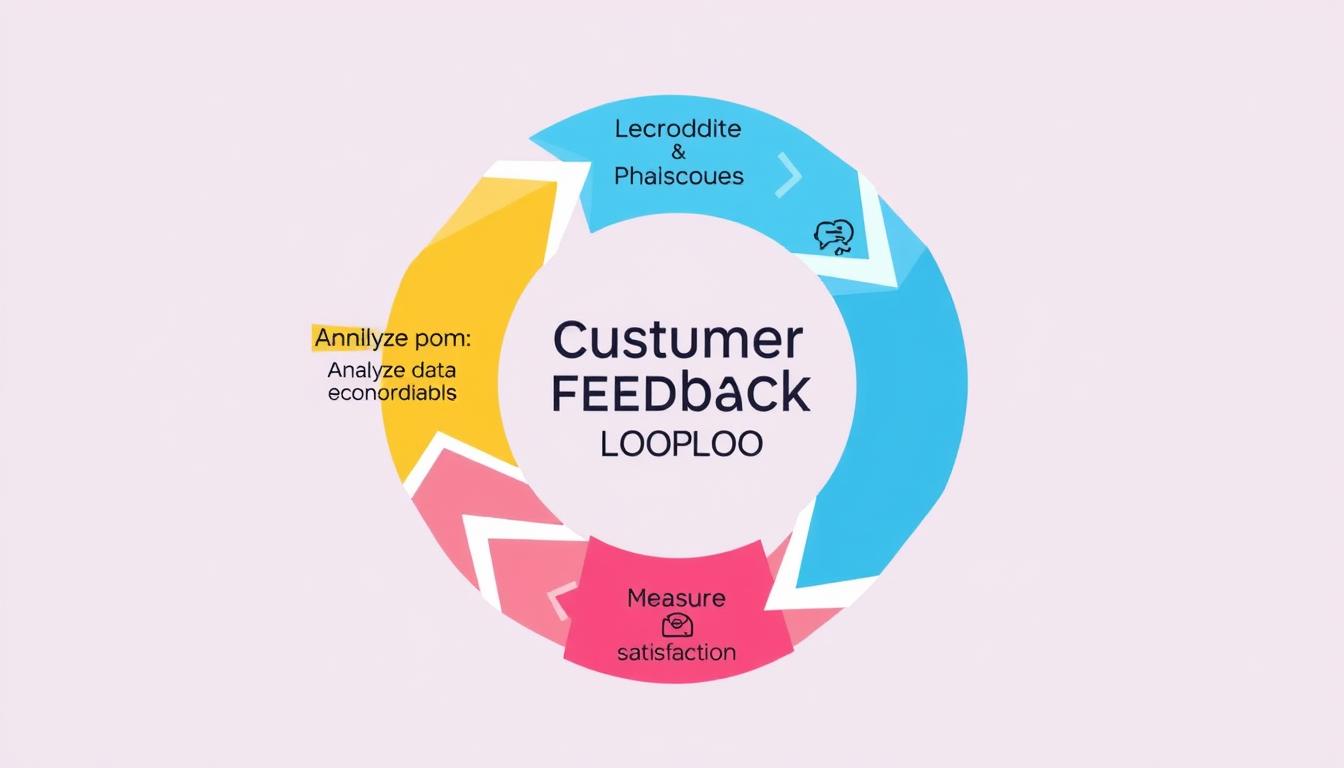Ever wondered how top companies stay ahead in making customers happy? The answer is simple: the customer feedback loop. This process not only makes customers happier but also helps businesses grow. Studies show that companies focused on customers are 60% more profitable1. Let’s explore how this strategy can change your business for the better.
In today’s market, making customers happy is key. People are willing to pay 16% more for a great experience1. By using a strong feedback loop, businesses can tap into this, boosting revenue by making customers happier, more loyal, and more likely to stay2.
A good customer feedback loop means gathering insights, analyzing them, making changes, and checking back with customers. This cycle shows you care about your customers and gives you valuable insights into what they think. These insights help teams across the company work together to serve customers better.
Customer experience is very important. A single bad interaction can cause customers to leave, with 32% of them ending a long-term relationship1. This shows how important it is to keep an eye on customer satisfaction by always asking for feedback and making things better.
By focusing on what customers say, businesses can see big improvements in scores like Net Promoter Score and Customer Satisfaction Score2. These scores show how happy customers are now and predict how they’ll act in the future, like buying again or telling others about your business2.
Key Takeaways
- Customer-centric companies see 60% higher profitability
- Customers will pay 16% more for better experiences
- 32% of customers may leave after one bad experience
- Feedback loops drive revenue through improved satisfaction and loyalty
- Prioritizing feedback improves key customer experience metrics
- Continuous improvement is crucial for maintaining customer relationships
Understanding the Customer Feedback Loop
The customer feedback loop is key to making products better with user input. It’s all about back-and-forth between companies and customers. This helps shape better customer experiences. By using a feedback loop, companies can make customers happier and improve their feelings towards the brand3.
A good feedback loop has four main steps:
- Collecting feedback
- Analyzing data
- Applying feedback and testing
- Following up with customers
This method is important for getting customer opinions and making products better for them. In fact, 88% of U.S. consumers like brands that listen to them3.
Feedback loops can be good or bad. Good loops make happy customers and show that things are working well. Bad loops are tough but help spot what’s not right and how to fix it4.
Here are tips to make the most of a customer feedback loop:
- Use shorter surveys to get more answers3
- Answer all feedback quickly4
- Turn insights into real changes4
- Use automation to collect feedback and follow up easily3
With a strong customer feedback loop, companies can focus on what customers want. This leads to happier customers and loyalty. In fact, 86% of consumers are willing to pay more for a better experience34.
| Feedback Type | Examples | Action Items |
|---|---|---|
| Positive | Excellent customer service, product solving key issues | Reinforce and expand successful practices |
| Negative | Poor customer service, complicated return processes | Analyze feedback, make necessary adjustments |
Collecting Customer Feedback: Methods and Best Practices
We know how crucial it is to get feedback from customers to make our products better. There are many ways to get valuable insights from them.
Survey tools are a top choice for getting feedback. Net Promoter Score (NPS) surveys measure how happy customers are and how likely they are to recommend us. Companies with the highest NPS often grow faster than their competitors5. Customer Satisfaction (CSAT) surveys check how satisfied customers are after they’ve had an interaction with us.
Online reviews give us a lot of information. Good and bad feedback from reviews can lead to changes. Customers are more likely to buy more from a company after a great experience5.

Live chat and social media let us get feedback in real time. Feedback widgets let customers share their thoughts without interrupting them6. This helps us fix issues quickly and make customers happier.
For SaaS companies, surveys about specific features can get useful feedback. Exit surveys when customers leave help us understand why they left6.
| Feedback Method | Benefits | Best Practices |
|---|---|---|
| NPS Surveys | Measure customer advocacy | Trigger at various touchpoints |
| CSAT Surveys | Gauge satisfaction after interactions | Use at multiple touchpoints |
| Online Reviews | Provide public feedback | Monitor and respond promptly |
| Live Chat | Offer real-time assistance | Train staff for quick, helpful responses |
| Social Media Monitoring | Capture unsolicited feedback | Use sentiment analysis tools |
By using these methods and best practices, we can build a strong feedback loop. This loop helps us improve continuously and make our customers happier.
Analyzing Feedback Data: Turning Insights into Action
Feedback analysis is key to understanding what customers want and fixing their issues. Our product and customer success teams work together to learn from what customers say. A big 58% of customers say they’d pay more for better service, showing how important this is7.
We get feedback in many ways:
- In-app widgets
- Customer portals
- Surveys
- Online reviews
- Social media comments
- Customer support interactions
We look for common themes and focus on what we can do next. We use tools like sentiment analysis and keyword analysis to spot patterns in what customers say7.

Companies that use data well can see five to eight times the return on investment. But, only 29% of companies can make their data actionable8. We work together to make changes based on what we find.
Here’s how we make feedback work for us:
| Step | Action | Team Involved |
|---|---|---|
| 1 | Summarize key findings | Customer Success Team |
| 2 | Identify recurring themes | Product Team |
| 3 | Develop action plan | Cross-functional |
| 4 | Implement changes | Development Team |
| 5 | Monitor impact | All Teams |
Using customer feedback helps us innovate and stay ahead. This way, we keep customers happy and loyal, which means they’re less likely to leave7.
Implementing Changes Based on Customer Feedback
We’ve collected and studied what our customers have to say. Now, we’re ready to make changes based on their feedback. Our aim is to update our products to match what our customers want. This means planning and testing carefully to make sure we’re meeting their needs.
A/B testing is a key way to put feedback into action. We can test two versions of a feature or update to see which one works best. This helps us make sure our changes are effective before sharing them with everyone.

Listening to our customers is key to doing well in business. Companies that focus on their customers tend to do much better. In fact, those that put customers first are 60% more profitable than others9. This shows how important it is to listen and act on what our customers say.
It’s important to keep our customers updated when we make changes. We use different ways to get feedback from them:
- NPS surveys on an 11-point scale
- CSAT surveys after key milestones
- Feature surveys for specific updates
- Always-on feedback widgets in our app
- Product betas for early adopter input10
By always listening and acting on feedback, we show we care about our customers. This builds trust and loyalty. In the U.S., 55% of consumers think most brands actually listen to their feedback9. By being responsive, we can be among the brands people trust and respect.
Responding to Customer Reviews: Closing the Loop
Closing the customer feedback loop is key to building strong relationships and boosting satisfaction. We know that 66% of customers want companies to understand their needs and expectations11. By using personalized responses and acknowledging customers, we can meet these expectations well.
When customers give feedback, it’s important to follow up with actions that fit their needs. This shows we care about their input and are serious about getting better. Companies that use feedback loops can find bugs and new features faster, making products and services better11.
For negative reviews, we can ask customers if they’re okay with updating their reviews after we’ve made changes. This shows we’re serious about getting better. And it gives us a chance to update reviews. Positive feedback can also be used as testimonials, helping to prove our quality on our website.
“Closing the loop with customers effectively is crucial for retaining key customers and maximizing revenue opportunities.”
By focusing on real follow-ups, not just generic answers, we can really boost customer loyalty and satisfaction12. This is key since keeping customers is much cheaper than getting new ones12.
| Benefits of Closing the Feedback Loop | Impact on Business |
|---|---|
| Increased customer engagement | Higher customer satisfaction |
| Reduced customer churn | Improved customer retention |
| Efficient product improvements | Enhanced service quality |
| Stronger customer relationships | Increased customer loyalty |
By using these strategies, we can build a strong feedback system. This system supports customer focus and keeps improving our products and services.
Measuring the Impact of Your Customer Feedback Loop
We’ve set up a customer feedback loop to get ahead and make our brand better. Our plan includes collecting, analyzing, acting, and following up13. This way, we learn what customers think and make things better for everyone.
We track how our feedback loop works by looking at things like Net Promoter Score (NPS) and Customer Satisfaction (CSAT)13. These numbers show how happy customers are over time. We also ask for feedback on our products to see what needs work14.

Our hard work has paid off. By quickly responding to reviews and asking for feedback in our app, we’ve made customers happier and our products better14. Now, our customers stick with us more and even tell others about us.
| Metric | Before Feedback Loop | After Feedback Loop |
|---|---|---|
| Customer Satisfaction Score | 72% | 89% |
| Net Promoter Score | +15 | +42 |
| Customer Retention Rate | 65% | 78% |
Using AI to understand feedback and share insights with our teams has made us more focused on our customers13. This has not just made our products and services better. It has also made us more open and trustworthy with our customers.
Automating the Feedback Process: Tools and Technologies
In today’s fast-paced business world, it’s key to automate feedback for better time management and customer satisfaction. Tools for marketing and feedback automation help collect and analyze customer insights quickly. This makes it easier for businesses to respond fast and effectively.
Customer experience tools are now vital for businesses aiming to improve their service. About 55% of US consumers think most businesses should work on their customer service15. Automation helps companies quickly address and solve customer issues before they get worse15.
Microsurveys are a strong tool in customer experience platforms. These short surveys fit right into the customer journey, making feedback easy to give. This method boosts survey response rates and gets more useful data by engaging customers more15.
Automation’s effect on customer loyalty is big. By being quick to respond to feedback and focus on improving experiences, businesses keep more customers15. This is important, as US businesses lose $136.8 billion a year because customers switch brands16.
Here are some key benefits of automating feedback:
| Benefit | Impact |
|---|---|
| Increased Customer Spending | Customers may spend 31% more on businesses with great reviews16 |
| Higher Purchase Likelihood | 92% of B2B buyers are more likely to purchase after reading positive reviews16 |
| Improved Team Productivity | Integration with task management tools saves time in organizing and assigning tasks16 |
| Enhanced Customer Insights | Automated text analysis helps understand large volumes of feedback16 |
By using these tools and technologies, businesses can make a more efficient and effective feedback loop. This leads to better customer experiences and growth for the business.
Conclusion: Fostering a Customer-Centric Culture Through Feedback
We’ve seen how customer feedback loops help build a culture focused on customers. Even though 95% of companies gather customer feedback, only 10% use it to get better17. This shows a big chance for businesses to stand out by always improving.
Listening to customer feedback can lead to more growth and loyal customers. Companies that put customers first are likely to grow 20% more and make 20% more profit by 202517. This shows the lasting benefits of listening to customers and acting on what they say.
The future of feedback loops looks promising. With AI, we could see a 25% jump in customer satisfaction by 202317. This tech boost, along with fast problem-solving, can make us 80% more connected to our customers18. Clearly, focusing on customers isn’t just smart – it’s key to staying ahead.
Let’s make sure to close the feedback loop. Doing so will boost customer happiness, cut down on losing customers, and increase how much customers spend over time18. Remember, 30% of customers are ready to pay more for better service18. By using feedback to focus on customers, we’re not just making our products and services better. We’re investing in our future success.
FAQ
What is a customer feedback loop?
Why is it important to collect customer feedback?
What are some methods for collecting customer feedback?
How should businesses analyze feedback data?
How can businesses implement changes based on customer feedback?
What is the importance of responding to customer reviews?
How can businesses measure the impact of their customer feedback loop?
What tools and technologies can automate the feedback process?
Why is implementing a customer feedback loop important for a business?
Source Links
- What is a Customer Feedback Loop and Why Do You Need One? – https://survicate.com/customer-feedback/loop/
- Feedback Loop in CX: What It Is & Why It Matters | InMoment – https://inmoment.com/blog/customer-feedback-loop/
- How to Create a Customer Feedback Loop That Works – Help Scout – https://www.helpscout.com/blog/customer-feedback-loop/
- What is a feedback loop? How to respond to positive and negative feedback loops – https://www.qualtrics.com/experience-management/customer/feedback-loop/
- Customer Feedback Strategy: The Only Guide You’ll Ever Need – https://www.hubspot.com/customer-feedback
- Customer Feedback Collection Methods and Best Practices for SaaS – https://userpilot.com/blog/customer-feedback-collection/
- Customer Feedback Analysis: From Raw Data to Actionable Insights | Zeda.io – https://zeda.io/blog/customer-feedback-analysis
- How to turn your customer feedback into actionable insights – https://getthematic.com/insights/how-to-get-actionable-insights-from-your-customer-feedback-analysis/
- Customer Feedback Loop: Importance and How to Close It – https://www.bolddesk.com/blogs/customer-feedback-loop
- Customer Feedback Loop: What is it and How To Close it – https://userpilot.com/blog/customer-feedback-loop/
- Best Practices for Closing the Customer Feedback Loop – https://rapidr.io/blog/closing-the-customer-feedback-loop/
- Customer Feedback Loops: 3 Examples & How To Close It – https://getthematic.com/insights/customer-feedback-loop/
- Customer Feedback Loop | Definition, Examples, Tips – https://www.asknicely.com/blog/customer-feedback-loop
- Customer Feedback Loops: Gathering Insights For Continuous Improvement – Custify Blog – https://www.custify.com/blog/customer-feedback-loops/
- Customer Feedback Automation in 2024 – https://research.aimultiple.com/customer-feedback-automation/
- 8 Practical Customer Feedback Workflow Automation Ideas – https://www.retently.com/blog/customer-feedback-automation/
- Closing the Feedback Loop: Enhancing Customer Success Through Feedback – https://www.linkedin.com/pulse/closing-feedback-loop-enhancing-customer-success-through-peter-hobert-uu1qe
- How to Create a Customer Feedback Loop and Make it Work – https://www.nudgenow.com/blogs/customer-feedback-loop-creation

